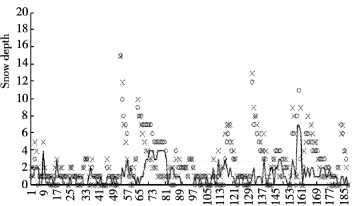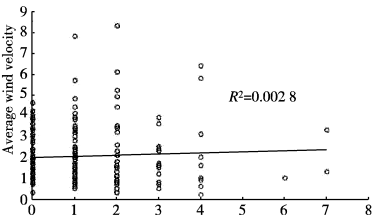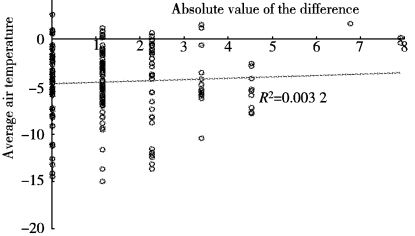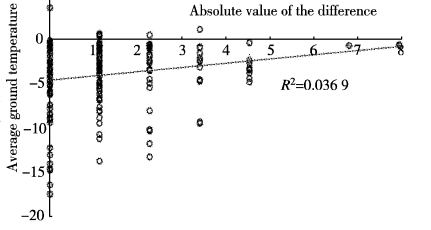The difference of snow depth measured by manual observation and ultrasonic sensor and its influencing factors
Snow cover directly or indirectly affects agricultural production, so monitoring snow depth is of great significance for agricultural production [13]. Snow depth observation is one of the basic observation items of National surface Meteorological observation Station, which refers to the vertical depth from the snow surface to the ground [4]. At present, there are two methods to measure snow depth in weather stations: manual measurement and automatic measurement instrument measurement. In the manual measurement method, 3 smooth sections near the meteorological observation field are selected for measurement even if snow ruler or ordinary meter ruler is used [4]. Automatic measurement method, according to the principle of ultrasonic and laser ranging using snow depth instrument for measurement [59]. With the development of meteorological modernization, it is becoming a trend to use automatic snow depth meter to measure snow depth.
At present, the meteorological department of Hebei Province is still based on manual measurement, automatic measurement method as a supplement, automatic measuring instruments are mostly ultrasonic snow depth instrument. However, there are few reports on the error of snow depth measured by ultrasonic sensor and artificial observation, the reason of difference and its influencing factors. In order to provide a scientific basis for the application of ultrasonic snow depth instrument and agricultural disaster prevention and reduction, the data of snow depth measured by two meteorological stations in Langfang and Zhangjiakou of Hebei Province from February 2014 to January and February 2015 were studied, including the error size, difference and influencing factors.
1. Materials and methods
1.1 The data of daily mean temperature, daily mean ground temperature and snow depth measured by artificial observation and ultrasonic sensor were obtained from six national meteorological stations, namely Chicheng, Weixian, Xuanhua and Xianghe, Langfang and Bazhou of Zhangjiakou City. After the quality control of Hebei Meteorological Information Center, the snow depth data of manual observation of wind speed, air temperature and ground temperature are deleted from the snow depth data measured by ultrasonic sensors and the data measured by uncalibrated snow depth instrument (according to the regulations, each station should calibrate the measuring basis of snow depth instrument before the winter every year), and 189 effective data are finally retained.
1. 2 Methods
1.2.1 Manual
Snow Depth Measurement Specification for Surface Meteorological Observation [4] compiled by China Meteorological Administration has detailed provisions on the observation area and measurement method of manual snow depth measurement. The snow depth value is the average value of three observation points (unit: cm).
1.2.2 Ultrasonic sensor to measure snow depth
1) Observation principle. Ultrasonic snow depth instrument mainly uses ultrasonic wave as the measurement signal, and calculates the distance between the sensor probe and the target object by measuring the time of ultrasonic pulse transmission and return. Since the sensor is installed at a fixed height, the snow depth can be monitored by continuous measurement [8]. Calculation formula [w]:

Where, D is the depth of snow cover; H is the distance between the ultrasonic sensor and the datum of measurement; V is the propagation speed of ultrasonic wave in air; f is ultrasonic round trip time.
2) Observation method. The core component of H S C S R 80 A snow depth monitor is 50 k H z ultrasonic piezoelectric sensor. The operating temperature of the snow depth instrument is 40 ~ 50°C, the measuring range is 0 ~ 2 500 mm, the resolution is 1 mm, and the snow depth value is input every 1 min (unit: mm). The measuring ski is marble, the length X width X height is 1 000 mmX1 000 mm X15 mm, and the installation height is flush with the ground of the observation field. Since air temperature is the main factor affecting ultrasonic propagation speed, ultrasonic propagation speed is compensated by temperature correction. The calculation formula is as follows:

Where, V is the propagation speed of ultrasonic wave in air; T is the air temperature.
1.3 Data processing
2. Results and analysis
2. 1 Snow depth measured by manual observation and ultrasonic sensor
As can be seen from Figure 1, the variation trend of snow depth measured by manual observation and ultrasonic sensor has a good consistency. Through correlation analysis, the snow depth values measured by the two methods have a very significant correlation, and the correlation coefficient is 0.801. According to the measurement of ultrasonic sensor, the maximum snow depth in Langfang was 3 cm, which appeared respectively at Langfang Station on February 21, 2015, Bazhou Station on February 22, 2017 and Xianghe Station on February 21, 2015. The maximum snow depth in Zhangjiakou City was 15 cm, which appeared in Chicheng Station on January 6, 2015. According to manual observation, the maximum snow depth in Langfang was 5 cm, which appeared at Langfang Station on February 21 and January 23, 2015 respectively. The maximum snow depth in Zhangjiakou City was 18 cm, which appeared in Xuanhua Station on January 6, 2015. The maximum absolute value of snow depth difference measured by the two methods was 7 cm, which appeared at Xuanhua Station on January 6 and 7, 2015. It can be seen that the maximum value of the absolute difference value generally occurs when the snow depth is at its maximum. Two methods were used to measure the snow depth. There were 83 cases of difference > 0, 60 cases of difference 0, 46 cases of difference < 0, and the difference was 0. 1 cm. The difference of absolute alignment value of 0 cm accounted for 31.7%, 1 cm accounted for 39.2%, 2 cm accounted for 15.9%, > 2 cm only 13.2%, when the difference of absolute alignment value of cm, 86. 0% of the snow depth was less than 2 cm, and the average absolute value of the difference was 1.2 cm. The mean value of the absolute difference value is less than the measured value of Liang Yanwei et al. [10], which may be due to the different ultrasonic snow depth sensors, observation methods and environmental factors. The average difference value is less than the measured value of Diduoet [11], which may be related to instruments, environment and data processing methods (According to the Specification for Surface Meteorological Observation, the average snow depth of artificial observation is less than ○ 5cm, denoting as 0, while Diduoet [11] assigned the value of trace snow as ○.5cm). From January 6 to 8, 2015, 159 to 161 snow depths measured by manual observation and ultrasonic sensor in Xuanhua Station of Zhangjiakou City (the 159th to 161st snow depth values) were 1 cm, 18 cm, 9 cm and 8 cm, l l cm and 3 cm, respectively, and the difference between the two values was large. It is 6 ~ 7 cm long. During this period, the precipitation of the station was 17.4 mm(20:00) and 15.1 mm and 8 mm respectively from 8:00 the next day. 2. 3 mm), 6. 7 mm(from 20:00 to 8:00 the next day) and 20. 00 to 8:00 the next day), the average temperature is 1. 5°C, 0. 1°C and 1. 8°C, and the average wind speed is 3. 4 m/s, l. 4 m/s and
1. 1 m/s, the average ground temperature is 0. 1°C, 0. 0°C and 0. 0°C, and there is no frozen soil. Among them, there will be sleet from 20:00 on the 6th to 8:0 on the 2nd.

Note: The snow depth data measured by manual observation and ultrasonic sensor are the first 42 in Langfang City and the 4th ~ 18th in Zhangjiakou City from February 2014 to January and February 2015.
Figure 1 Snow depth measured by manual and ultrasonic sensors and the absolute value of the difference
Speculation: It may be because the temperature of the snowboard measured on the 6th day is lower than that of the ground (especially when the temperature is <0°C from 2:00 to 8:00, and the soil temperature is all >0°C), there is a large amount of snow and sleet, and the snowboard is more likely to freeze, resulting in thicker snow on the snowboard. From July to August 8, as the temperature rose and the snow melted, the liquid water on the snowboard increased, and its thermal conductivity and heat capacity increased, leading to faster snow melting [1213]. It shows that the surface temperature is the main indirect influence factor in the study area, and the snowboard is the main direct influence factor.
2. 2 Influence of different factors on the absolute value of depth difference measured by manual observation and ultrasonic sensor
Snow wind speed, air temperature, soil frost, snow blowing, snowboard material and configuration [3m 15] will affect the absolute value of snow depth difference measured by manual observation and ultrasonic sensor. The correlation analysis showed that the absolute difference was not significantly correlated with air temperature and wind (0. 05 3 and 0. 056), but was significantly positively correlated with ground temperature (0. 192 "), indicating that ground temperature was the main meteorological influencing factor in the study area.
2.2.1 Wind Speed
From Figure 2, it can be seen that the absolute difference values of the two methods from February 2014 to January and February 2017 show a weak positive correlation with the average wind speed (CR2= ○.0028), and the wind speed has little influence on the absolute difference values of the two methods. Only when the snow depth and wind speed are both large, the wind speed has an influence on the absolute difference values of the two methods. During the period, the daily mean wind speed > 4.0m /s lasted for 16 days, while the absolute difference value > 3 cm lasted only for 2 days. The average wind speed of Xuanhua Station on January 22, 2015 was 5.8 m/s, the snow depth measured by manual observation was 5 cm, the snow depth measured by ultrasonic sensor was 6 cm, and the absolute value of the snow depth difference was only 1 cm, indicating that the wind speed was not the main factor affecting the absolute value of the difference between the two methods. It is inconsistent with the research results of Liang Yanwei et al. [1()]. It may be caused by the fact that there are few data with large wind speed and large absolute difference at the research site. However, wind speed will affect the snow depth measured by ultrasonic sensors. For example, the ultrasonic snow depth value of 4 m in (40.02 cm) and 41 m in were missing from 13:00 to 14:00 on February 26, 2014 at Weixian Station. The interphase air temperature and ground temperature were above ○ °C, and the average wind velocity was 6.3 m/s. In this station, there was snow at 2:00 on January, January, 1st, 2016, and the wind speed was also relatively high, with the instantaneous wind speed reaching 4.9 m/s. The ultrasonic measurement showed that the snow was deep
4 min outage (40.9 cm) and 8 min missing test are present. The phenomenon of outage and missing measurement may be caused by the sensor being blocked by ice or snow due to blowing snow during the snowfall.

FIG. 2 Relation between absolute snow depth difference and average wind speed from February 2014 to December 2017
2.2.2 Air Temperature The influence of air temperature on the absolute value of the difference
It is mainly manifested in two aspects: first, the temperature will affect the stroke of ultrasonic pulse and the performance of the sensor; second, when the temperature is higher, the ultrasonic sensor water damage the snow surface, causing the distortion of the measured value of the instrument, and the difference between the two methods of measurement. It can be seen from Figure 3 that from February 2014 to January and February 2017, the absolute value of the difference between the two methods showed a weak positive correlation with the mean temperature, CR2= ○.003 2), which was little affected by temperature. Possible causes: First, the HSC-SR80A ultrasonic sensor has temperature compensation; Second, there are few days when the daily maximum temperature is > 0 °C and the snowfall is large, so the number of days when the ultrasonic sensor dripping damages the snow surface is also small.

FIG. 3 Correlation between absolute pairs of snow depth difference and mean air temperature from February 2014 to December 2017
2.2.3 Ground temperature As shown in Figure 4, the absolute difference values of the two methods from February 2014 to January and February 2017 are positively correlated with ground temperature, CR2= ○.036 9), and the correlation trend is greater than that of wind speed and air temperature. Possible cause: The snow depth measurement surface of manual observation and ultrasonic snow depth instrument is different. The underlying surface of snow depth observation is soil, while the datum surface of snow depth measurement by ultrasonic snow depth instrument is 15 m m thick marble slab. Due to different underlying surface, the physical characteristics of snow, soil water and heat exchange and their interaction are different, especially when the ground temperature is relatively high. Therefore, the indirect influencing factor is mainly ground temperature, while the direct factor is underlying surface.

2.2.4 Other factors The inconsistent number of observation points and different material of measurement surface of the two methods are two external factors that affect the difference between them. Different measuring surface materials may lead to different snow and snow melting speed, thus affecting the difference value. The different number of observation points will certainly affect the absolute value of the difference between the two methods. The main reason is that the ultrasonic sensor is located in the observation field, and there is only one set of instrument. The manual observation method is to take the average value of three observation points with a phase distance of less than 10 m outside the observation field, that is, the number of observation points of the two is inconsistent. Local factors such as solar radiation, wind and surface characteristics are different, which affect the difference between the two methods through wind blowing snow and snow melting.
3 Conclusion and discussion
With the automatic and intelligent development of meteorological observation service and meteorological observation equipment, automatic snow depth meter will gradually replace manual observation. The snow depth measured by manual observation and ultrasonic sensor and the absolute difference value were analyzed, and the influence of air temperature, wind speed, ground temperature and other factors on the snow depth measured by the two observation methods was discussed. The results show that the trend of snow depth measured by manual observation and ultrasonic sensor is in good agreement, and the correlation coefficient is 0. 801. The average value of snow depth measured by manual observation is larger than that measured by ultrasonic sensor, and the average value of the absolute difference is 1.2 cm. Air temperature, wind, ground temperature and snowboard all have influence on the absolute value of difference between the two observation methods, among which ground temperature is the main indirect influence factor and snowboard may be the main direct influence factor.
The error of snow depth measurement between manual observation and ultrasonic sensor. Wu Shucheng et al. [6] suggested that the material of the datum surface for snow depth measurement should be further improved, and that more than 20 cm of soil should be buried under the snowboard. Liang Yanwei et al. [10] suggested that the installation site of ultrasonic snow depth instrument should be selected in an area with good wind shelter conditions or adopt wind shelter measures, and the average value should be measured by multi-point observation. In addition, in order to eliminate and avoid the errors of the two observation methods, observers should pay attention to two points: First, since the maximum of the absolute value of the difference generally occurs when the snow depth is at its maximum, when the snow depth of any measurement method is greater than 4 cm, the observer should pay attention to the data difference of the two observation methods, and record the underlying surface or influencing factors measured by the two observation methods when the absolute value of the difference is greater than 1 cm. Second, when there is snow and snow, the snow on the ultrasonic snow depth sensor should be removed in time to avoid the impact on the measurement value when it melts. In conclusion, in order to improve the accuracy of ultrasonic snow depth meter measurement, more tests and improvement of snow depth sensor are needed. Meanwhile, observers should also try to keep the original record and control the quality of the data.



